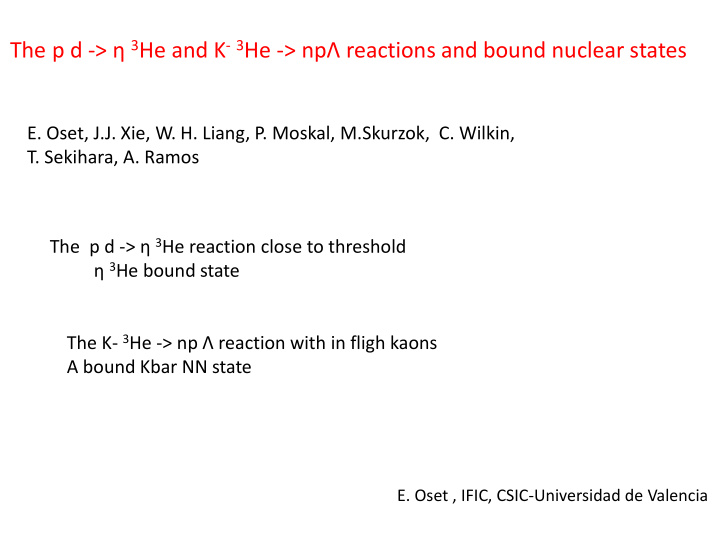



The p d -> η 3 He and K - 3 He -> np Λ reactions and bound nuclear states E. Oset, J.J. Xie, W. H. Liang, P. Moskal, M.Skurzok, C. Wilkin, T. Sekihara, A. Ramos The p d -> η 3 He reaction close to threshold η 3 He bound state The K- 3 He -> np Λ reaction with in fligh kaons A bound Kbar NN state E. Oset , IFIC, CSIC-Universidad de Valencia
Fits to these data have been done before They get a small binding and very narrow width This is in contrast with all calculations, that give Γ > B Garcia-Recio, Nieves, Inoue, E. O PLB (2002)
Theoretical approach Primary transition Rescattering of eta S-wave in eta 3 He Primary transition P-wave in eta 3 He Eta rescattering V is an optical potential, complex Full transition amplitude t= (VP + V1P) (1+GT)
Construction of T This is only used to establish the range of the interaction Momentum space s-wave projected The term […] is essentially 1 in the range of study and, thus, the potential is separable
But we do not take Take instead will be a fit parameter
S-wave
Asymmetry
[22] [23]
Structure near K − + p + p threshold in the in-flight 3 He ( K − , Λ p ) n reaction JPARC E15, PTEP 2016, 051D01
Theoretical interpretation If we want to produce a Kbar NN system, we must get the first rescattered Kbar as much at rest as possible . This happens at 1Gev/c and backward scattering in CM. The n goes forward in the lab system.
Different orders of the interactions amount to a factor 6 in the cross section when this wave function is explicitly considered. Jacobi coordinates are used for the 3He. We introduce a witdth for the Kbar to account for Kbar aborption by two nucleons based on the work of Bayar, Oset PRC 88 , 044003 (2013)
B= 20 MeV, Γ =75-80 MeV In Bayar’s paper it is shown that this can be taken into account taking a Kbar width of about 15 MeV. This is the only work in which the Kbar absorption by two nucleons is evaluated. It provides about 30 MeV more to the width of the Kbar NN state.
Six configurations:
…………………
Watson approach
Truncated Faddeev approach
This figure shows that the shape is mostly induced by setting the Kbar propagator on shell after the first rescattering. Not due to the Λ (1405), which is not here.
Results including Kbar rescattering that leads to the binding of the Kbar NN system
3. KNN bound state ++ Numerical results ++ ■ We calculate the mass spectrum and cross section in scenario II. Mass spectrum □ One Angular distribution more thing: Our spectrum has a “double peak” structure around the KNN threshold. --- The M ( K -- pp ) lower peak is 2 MENU 2016 @ Kyoto (Jul. 25 - 30, 2016) the 5
The integrated strength is σ = 7 μ b , in also good agreement with experiment Our conclusion would be that the peak observed gives support to the existence of the so much searched Kbar NN state. The agreement of our results with experiment would say that B ~ 20 MeV and Γ~ 80 MeV Similar to Dote, Hyodo, Weise (include K - absorption perturbatively) Ikeda, Sato with energy dependent potential Barnea, Gal, Liverts But the width is bigger because of the accurate evaluation of K - absorption
Recommend
More recommend